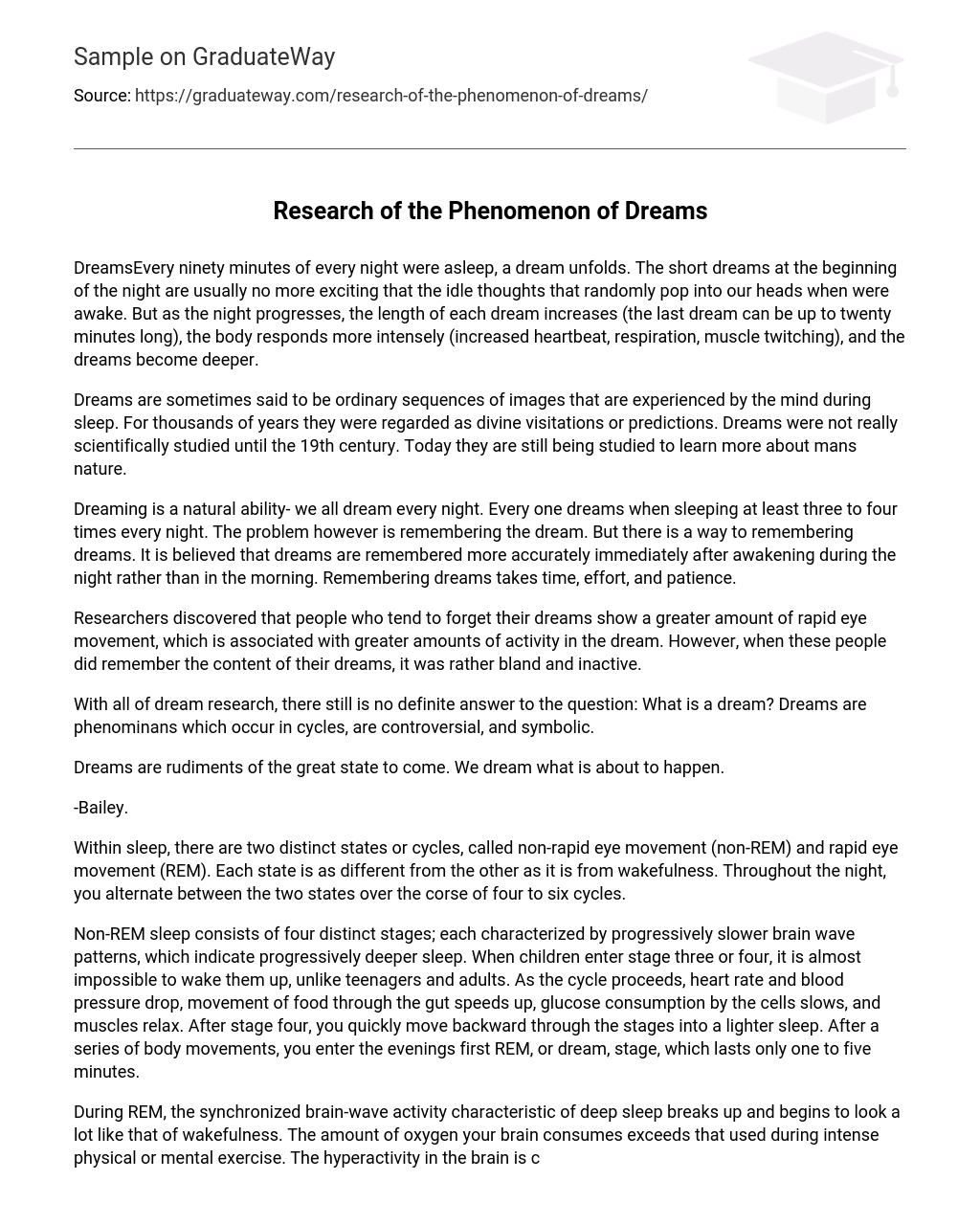DreamsEvery ninety minutes of every night were asleep, a dream unfolds. The short dreams at the beginning of the night are usually no more exciting that the idle thoughts that randomly pop into our heads when were awake. But as the night progresses, the length of each dream increases (the last dream can be up to twenty minutes long), the body responds more intensely (increased heartbeat, respiration, muscle twitching), and the dreams become deeper.
Dreams are sometimes said to be ordinary sequences of images that are experienced by the mind during sleep. For thousands of years they were regarded as divine visitations or predictions. Dreams were not really scientifically studied until the 19th century. Today they are still being studied to learn more about mans nature.
Dreaming is a natural ability- we all dream every night. Every one dreams when sleeping at least three to four times every night. The problem however is remembering the dream. But there is a way to remembering dreams. It is believed that dreams are remembered more accurately immediately after awakening during the night rather than in the morning. Remembering dreams takes time, effort, and patience.
Researchers discovered that people who tend to forget their dreams show a greater amount of rapid eye movement, which is associated with greater amounts of activity in the dream. However, when these people did remember the content of their dreams, it was rather bland and inactive.
With all of dream research, there still is no definite answer to the question: What is a dream? Dreams are phenominans which occur in cycles, are controversial, and symbolic.
Dreams are rudiments of the great state to come. We dream what is about to happen.
-Bailey.
Within sleep, there are two distinct states or cycles, called non-rapid eye movement (non-REM) and rapid eye movement (REM). Each state is as different from the other as it is from wakefulness. Throughout the night, you alternate between the two states over the corse of four to six cycles.
Non-REM sleep consists of four distinct stages; each characterized by progressively slower brain wave patterns, which indicate progressively deeper sleep. When children enter stage three or four, it is almost impossible to wake them up, unlike teenagers and adults. As the cycle proceeds, heart rate and blood pressure drop, movement of food through the gut speeds up, glucose consumption by the cells slows, and muscles relax. After stage four, you quickly move backward through the stages into a lighter sleep. After a series of body movements, you enter the evenings first REM, or dream, stage, which lasts only one to five minutes.
During REM, the synchronized brain-wave activity characteristic of deep sleep breaks up and begins to look a lot like that of wakefulness. The amount of oxygen your brain consumes exceeds that used during intense physical or mental exercise. The hyperactivity in the brain is coupled with an almost total loss of muscle control throughout the body. The alternative name for this is called the paradoxical sleep. Only the muscles controlling the eyeswhich alternate between slow rolling and rapid bursts of movementthe muscles controlling the middle ear, and the muscles involved in breathing escape paralysis.
After this first cycle, the lengths of deep sleep (stages three and four) periods decreases, while duration of REM, or dreaming, episodes increase. Most deep sleep occurs in the first third of the night, most dreaming in the last third.
With a lot of research, dreams remain very controversial. It dates back to Sigmund Freud and Carl Jung. According to Freud, dreams have two principal functions: to attempt to fulfill repressed, unconscious wishes, mainly sexual and aggressive desires. Freud held that contents of dreams consist of memories but that the stimulus for a dream is always an unconscious wish that has origin in childhood.
On the other hand, Jungs view of the function of dreams- compensation for aspects of the dreamers personality that have been neglected in his conscious life- does not differ substantially from Freuds wish-fulfillment theory.
The main difference between the two scientists theories is that, Freud ascribed dreams to infantile wishes, Jung held that they originate in the inborn thought pattern (or archetypes) of a radical unconscious common to all mankind.
When dreaming, the dreams are filled with many different people, places and objects you know but, almost all the time, these are really symbols that are telling you something about you and your life.The interpretation of dreams can be accomplished by dividing the dream into its constituent parts: then the subject reports whatever he immediately associates with each of the elements. Feelings and emotions can however effect your dream. They are reflections of you when you are awake. Even little objects such as a pen can symbolize something really big. In this case a pen symbolizes and foretells you are unfortunately being led into serious complications by your love of adventure. The meaning of all symbols depends on the person themselves. They can vary from person to person, which are called personal symbols. There is however symbols which mean fundamentally the same thing for most people. These symbols are called universal symbols.
Dreams are phenomenans which occur in cycles, are controversial and symbolic.
Miscellaneous





